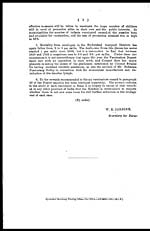Medicine - Vaccination > 1872-1903 - Report on vaccination in the Hyderabad Assigned Districts > Vaccination Hyderabad 1890-1903 > Notes on the annual returns of vaccination in the Hyderabad Assigned Districts for the year 1899-1900
(311) [Page 1]
Download files
Individual page:
Thumbnail gallery: Grid view | List view
![(23) [Page 1] -](https://deriv.nls.uk/dcn17/9117/91173836.17.jpg)
Extract from the Proceedings of the Resident at Hyderabad, No. 2528, dated
Hyderabad Residency, the 5th July 1900.
READ—
The Notes on the Annual Returns of Vaccination in the Hyderabad Assigned Districts for the year
1899-1900.
RESOLUTION.
The Report on Vaccination in the Hyderabad Assigned Districts during
1899-1900 was received from the Sanitary Commissioner on the 15th May
1900, and the Commissioner's review on the 20th June.
2. The year under report is chiefly remarkable for a large increase in the
number of operations, the highest ever recorded in Berar, the employment
unavoidably of lanoline lymph instead of calf lymph, and a small fall in the
ratio of success. The operations of the last four years are compared in the fol-
lowing statement:—
|
— |
Primary |
Percent- |
Re-vaccina- |
Percent- |
Total oper- |
Cases for |
Cost per |
||
|
Rs. |
a. |
p. |
|||||||
|
1896-97 ... |
98,594 |
96.8 |
21,717 |
20.5 |
120,311 |
2,729 |
0 |
2 |
9 |
|
1897-98 ... |
95,048 |
96.4 |
30,241 |
30.0 |
125,289 |
2,847 |
0 |
2 |
9 |
|
1898-99 ... |
94,032 |
97.1 |
38,871 |
23.1 |
132,903 |
3,020 |
0 |
2 |
9 |
|
1899-1900 ... |
120,772 |
95.8 |
55,129 |
17.2 |
175,901 |
3,997 |
0 |
2 |
3 |
3. The excellent results achieved during the year under report, the num-
ber of successful primary vaccinations being 115,789 and re-vaccinations 9,522,
or 125,311 in all, as against 100,762 and 100,275 in the two preceding years,
are attributed by the Sanitary Commissioner in great measure to the influx of
unvaccinated people from Hyderabad territory in search of famine relief, which
the district returns seem to bear out, a large increase being observable in the
vaccination returns of districts on the Hyderabad frontier, to the congregation of
suitable subjects on relief works, and the facilities offered by the use of lanoline
lymph, the large increase in the number of primary operations being further
due to the abnormally high birth-rate of 50.5 per mille in 1899, as is shown
by the fact that the number of infants under one year of age vaccinated during
the year was 96,180 against 69,887 in 1898-99.
4. On the other hand, the number of infants under one year of age re-
maining to be vaccinated rose from 5,230 in 1897-98 and 2,906 in the follow-
ing year to 14,501 in 1899-1900. This circumstance and the fall in the ratio
of success attributed by the Sanitary Commissioner to the comparative
weakness of lanoline lymph (in which case re-vaccination may be expected
to show an increase in the ratio of success in years to come) are items
in the year's profit and loss account which must not be overlooked. Nor
must it be forgotten that the high rate of protection (43.2) attained this year in
the Hyderabad Assigned Districts is based on returns which include operations
on immigrants not forming part of the normal registered population. The
use of lanoline lymph was necessitated by the difficulty experienced in getting
suitable calves; and for its timely introduction in an economical manner
Colonel Swaine deserves much credit. The Resident trusts, however,
that calf lymph will be reverted to as soon as circumstances permit, and that
Set display mode to: Large image | Zoom image | Transcription
Images and transcriptions on this page, including medium image downloads, may be used under the Creative Commons Attribution 4.0 International Licence unless otherwise stated. ![]()
| Permanent URL | https://digital.nls.uk/91173834 |
|---|
| Attribution and copyright: |
|
|---|




